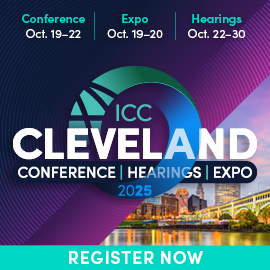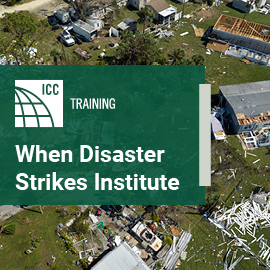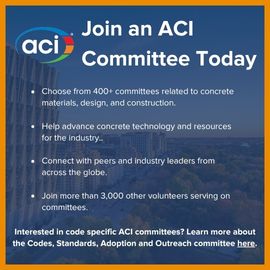
Code changes on A2L refrigerants
During the 2021 Group A code cycle, several proposed changes were submitted for the International Building, Fire and Mechanical Codes that would permit the usage of A2L refrigerants
Nearly 200 years have passed since Jacob Perkins patented the vapor-compression cycle in 1835, which began the history of refrigerants. The vapor-compression cycle uses a refrigerant to transport heat from the cold side to the hot side of a refrigeration system, heat pump or air-conditioning system. We use the same thermodynamic cycle today, though the refrigerants have changed.
A brief history of refrigerants
In the beginning, all refrigerants existed in nature or were used in industrial processes, and thus, were easily obtainable. By the 1930s, critical safety issues involving many of these early refrigerants emerged, including cases of fires and poisoning caused by refrigerant leaks. Synthetic safety refrigerants (chlorofluorocarbons or CFCs) were then invented and deployed on a global scale, with the development of partially chlorinated refrigerants (hydrochlorofluorocarbons or HCFCs) continuing in the 1950s. By the early 1970s, it was discovered that CFC and HCFC refrigerants caused a breakdown of the ozone layer. In particular, while HCFCs are comparatively lower in ozone-depleting potential and CFCs have a particularly high ozone-depleting potential, both still wreak havoc. The low reactivity of CFCs gives them a lifespan that can exceed 100 years, giving them time to diffuse into the upper stratosphere, where ozone loss could result in harm to our health and to our environment.
In response to a dramatic seasonal depletion of the ozone layer over Antarctica, in 1987 Canadian diplomats forged a treaty, the Montreal Protocol, that called for drastic global phasedowns in the production of CFCs that deplete the ozone layer. It went into effect in 1989, reducing the ozone-depleting potential load in the atmosphere and considerably decreasing the global-warming impact. Substitute refrigerants (hydrofluorocarbons or HFCs) replaced the void left by CFCs and HCFCs. While HFC refrigerants have an ozone-depletion potential of zero, they are potent greenhouse gases with a medium-to-high global warming potential (GWP). Their usage has been scrutinized and they are included in the Kyoto Protocol and are regulated under the 2019 Kigali Amendment to the Montreal Protocol due to their contributions to climate change. (Refrigerants are classified by their global warming potential, a metric that compares the total contribution of a given mass of the refrigerant gas to an equivalent mass of carbon dioxide or C02.)
Many refrigerants, including HFCs, are potent greenhouse gases. Scientific investigations show that while refrigerant systems are not intentionally vented to the atmosphere, since industrial refrigeration systems frequently require charges of hundreds of pounds of refrigerant, a leaky refrigerant system — especially within air-conditioning units in developing countries — can have an immense impact on global warming. Their growing consumption in building systems would eventually make HFCs a top global-warming contributor if phasedown measures were not introduced. In late 2021, the United States Environmental Protection Agency (EPA) issued a rule, the first regulation under the American Innovation & Manufacturing (AIM) Act of 2020, effectively implementing legislation that mandates an 85-percent economy-wide phasedown in HFC refrigerants over the next 15 years. The phasedown is expected to avoid HFC emissions of 900 million metric tons of CO2-equivalent by 2035 and avoid up to 0.5 degrees Celsius of global warming by 2100.
Next-generation refrigerant A2L
According to the International Institute of Refrigeration, refrigeration technology and air conditioning take up about 15 percent of the electricity consumption worldwide, making the quest for energy-efficient solutions ever more relevant. Just as HFC refrigerants replaced the void left by CFCs and HCFCs, the phasedown of HFCs has ramped up a growing acceptance of the use of A2L refrigerants as a substitute in many applications. The A2L subgroup, as categorized by ASHRAE Standard 34, are a class of refrigerants that have lower toxicity and flammability (flame propagation speed is less than 10 cm/s) compared to other classifications — A = non-toxic, 2 = flammable, L = low burning velocity — making it the second-safest refrigerant category. The A2L refrigerants also have a significantly lower global warming potential than A1-class HFCs, so A2L use is a key part of the HFC reduction plan. Globally, A2Ls have been used safely for years. As of December 2018, more than 68 million air conditioners using A2L refrigerants have been installed around the world.
Obtaining sustainable refrigerant solutions is a fine balance between affordability, safety and environmental concerns. Last year, the EPA adopted a final rule accepting six refrigerant alternatives for use in new residential and light commercial air conditioners and heat pumps that meet the requirements in UL 60335-2-40 (Edition 3) for air-conditioning equipment. Each lower GWP alternative — R–32, R–452B, R–454A, R–454B, R–454C and R–457A — is classified by ASHRAE as A2L (mildly flammable).
A2L code change proposals approved
Since A2Ls are new to the U.S. and these replacement refrigerants have different flammability characteristics, safety, training and building code updates are important considerations. During the 2021 Group A code development cycle, several proposed code changes were submitted for the International Building Code (IBC), International Fire Code (IFC) and International Mechanical Code (IMC) that would permit the usage of A2L refrigerants, consistent with ASHRAE Standard 15-2019 and UL 60335-2-40, which are referenced in the EPA’s rulemakings. Fourteen code change proposals were approved that impact the use of A2L refrigerants for human comfort; four proposals submitted for the IBC, four submitted for the IFC and six submitted for the IMC. (These approvals are subject to certification by the ICC Validation Committee and confirmation by the International Code Council Board of Directors in accordance with Section 10.1 of Council Policy 28 — Code Development.)
Approved changes to the IBC and IFC include:
- Differentiation of lower flammability refrigerants from other higher flammability gases in storage by using the classifications and labeling provisions of the 7th edition of the Globally Harmonized System of Classification and Labelling of Chemicals, and
- for correlation with the IMC.
Approved changes to the IMC (related to A2L refrigerants) are as follows:
- High probability equipment using Group A2L, A2, A3 or B1 refrigerant shall comply with UL 484, UL/CSA 60335-2-40, or UL/CSA 60335-2-89. By adding this requirement, the code clarifies what safety standards should be used for equipment utilizing these refrigerants. This is consistent with the ASHRAE 15 Standard, Safety Standard for Refrigeration Systems.
- IMC refrigerant Table 1103.1 was updated with the new refrigerants that have been added to the ASHRAE Standard 34, Designation and Safety Classification of Refrigerants, since the last code cycle. Table 1103.1 is now consistent with ASHRAE 34.
- High probability direct systems for human comfort must use either Group A1 or A2L refrigerant. Other refrigerants can be used provided the maximum charge does not exceed 6.6 pounds for residential applications and 22 pounds for commercial units. This requirement is consistent with ASHRAE 15.
- Machinery rooms for Group A2L and B2L refrigerant must comply with elevated temperature, refrigerant detector and mechanical ventilation requirements consistent with ASHRAE 15.
- The new ASTM A333-18 Standard, Standard Specification for Seamless and Welded Steel Pipe for Low-Temperature Service and other Applications with required Notch Toughness, has been added to Table 1107.4, Refrigerant Pipe. Table 1107.4 is now consistent with ASHRAE 15.
Through 2021, except in limited instances, the IMC did not permit A2L refrigerants for human comfort uses. The fire service had safety concerns about A2L flammability, but these have been recently resolved through additional analysis by the Air Conditioning, Heating and Refrigeration Institute with testing performed by UL (Underwriters Laboratories).
These approvals, which go into effect with the 2024 IBC, IFC and IMC, permit the use of A2L refrigerants for human comfort uses, consistent with industry standards, and will help to facilitate the phasedown of HFCs following EPA rules.
Frequently asked questionsWhat is a refrigerant? What are A2L refrigerants? Which refrigerants are classed as A2L? Are A2L refrigerants just a phase? What’s driving the adoption of A2L refrigerants? Is there additional research for A2L refrigerants? |
Legislation driving the next generation of refrigerants
Understanding that the U.S. needed to move to a next-generation refrigerant, the bipartisan AIM Act — which was included in the Consolidated Appropriations Act of 2021 — was signed into law in December 2020. Among other things, the legislation grants the EPA the authority to regulate the transition to next-generation refrigerants and implement a phasedown of the production and consumption of HFCs over the next 15 years, mirroring the Kigali Amendment phasedown. The application-specific program went into effect on Jan. 1, 2022, and allowances — representing the privilege granted to a company to produce or import HFCs in a given year — will be required for the production and consumption of HFCs.
The EPA’s Significant New Alternatives Policy (SNAP) program was established under Section 612 of the amended Clean Air Act of 1990 and evaluates and approves alternatives to substances heavily reliant on HFCs within a comparative risk framework in major industrial use sectors. The SNAP program continuously generates evolving lists of acceptable and unacceptable substitutes to promote a smooth transition to safer alternatives. Manufacturers, refrigerant producers and users can submit a proposed substitute for consideration, and the program evaluates overall risks to the environment and human health.
Conclusion
More than ever, refrigerants are a necessity in a world where cooling and heating needs are growing. The selection of the right refrigeration has a great impact. While some of yesterday’s solutions have had consequences for today’s environment, it is imperative that the industry looks ahead to find future-proof solutions to current challenges. Doing so effectively will require a solid working knowledge of the current standards, legislation and emerging technologies, and an eye on the future in terms of safety and environmental responsibility.
References
The article findings for the code change proposals impact the use of A2L refrigerants for human comfort are based on the following code change proposals for the IBC, IFC and IMC submitted during the 2021 Group A code development cycle:
- F3-21 — proposed changes to the IBC and IFC — Section 202.
- F98-21 — proposed changes to the IBC and IFC — IFC Table 911.1 and IFC Section 3307.2.1; IBC Table 414.5.1.
- F192-21 — proposed changes to the IBC and IFC — IFC Table 5003.1.1(1), Table 5003.1.1(3), Section 5003.8.3.5, Section 5003.8.3.5.4 (new), Section 5003.11, Section 5003.11.1, Section 5003.11.2, Section 5003.11.3, Section 5003.11.3.1, Section 5003.11.3.2, Section 5003.11.3.3, Section 5003.11.3.4, Section 5003.11.3.5, Section 5003.11.3.7, Section 5003.11.3.6, Section 5003.11.3.8, Section 5003.11.3.9, Section 5003.11.3.10, Section 5003.11.3.11, Section 5003.11.2 (new), Table 5003.11.2 (new), and Section 5003.11.2.1 (new); IBC Table 307.1(1), Section [F] 414.2.5, Table 414.2.5(3) (new), and Section 414.2.5.4 (new).
- G41-21 — proposed changes to the IBC — IBC Section [F] 307.4 and Section [F] 307.5.
- M72-21 — proposed changes to the IMC — Section 1101.2.1 (new), UL Chapter 15.
- M74-21 — proposed changes to the IMC — Table 1103.1.
- M75-21 — proposed changes to the IMC — Section 1104.3.1, Section 1104.3.2, and Table 1104.3.2.
- M77-21 Part I — proposed changes to the IMC — Section 1106.3.
- M77-21 Part II — proposed changes to the IFC — Section 608.17.
- M78-21 Part I — proposed changes to the IMC — Section 1106.4, Section 1106.4.1 (new), Section 1106.4.2, Table 1106.4.2 (new), Table 1106.4.2, and Section 1106.4.3.
- M83-21 — proposed changes to the IMC — Table 1107.4, Table 1107.5, Section 1107.7, Section 1109.2.2, Section 1109.2.3, Section 1109.2.6, Section 1109.2.7, Section 1109.3, Section 1109.3.1, Section 1109.3.2, Section 1109.4, Section 1109.4.1, Section 1109.4.2, Section 1109.7, Section 1110.3, Section 1110.3.1 (new), Section 1110.5, Section 1110.5.2, Section 1110.5.1, Section 1110.6, Section 1110.7, and ASTM Chapter 15 (new).
The specific code changes and public comments can be viewed here.









